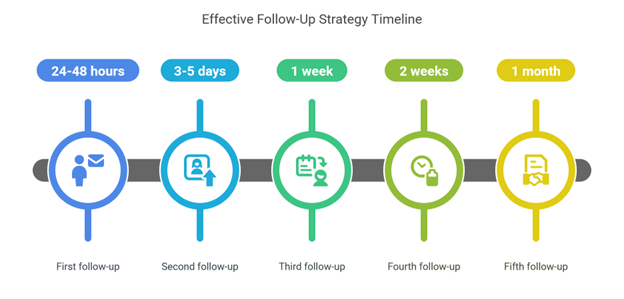Let me tell you something. The reality is most deals do not conclude after the first conversation.
First interactions with a prospect merely the beginning of a longer lead generating and sales process. Closing the deal after one meeting is hardly feasible even with a strong pitch.
Often what distinguishes effective from unsuccessful sales campaigns is including the follow-up into your sales process.
Following up with prospects regarding your product or service is only one aspect of it. It also offers value and helps leads make decisions, hence preserving relationships.
Sadly, many salespeople overlook this important component of the sales cycle.
What is Sales Follow-Up?
Sales follow-up is the action taken to keep in touch, maintain the relationship, and push a prospect along the sales funnel after a salesperson first contacts a prospect. Following up keeps leads intriguing and points them toward a purchase decision.
Depending on the lead and product or service, the sales follow-up method could call, email, use social media, or visit personally.
Many businesses, especially B2B, have long and complicated sales cycles that call for several contacts with prospects prior to purchase. Strong follow-up helps the sales team to stay in the prospect’s mind even as it addresses problems and builds confidence.
The Differences Between Cold, Warm, and Hot Leads
Let’s review the difference between cold, warm, and hot leads before we dig deeper into a follow-up campaign. Understanding the difference will help you to modify your approach and improve sales conversions.
Cold Leads
Cold leads are potential clients still discovering your brand. They might be your future clients but not know about your offerings. Usually, cold leads come in the early stage of the buyer journey. Cold outreach helps one to obtain them. They might also be more important than the other two lead types.
Warm Leads
Warm leads demonstrate interest in your product or service. They show interest in your brand but are still waiting for a chance to purchase. They might visit your pricing page, download materials, or register for your newsletter. Warm prospects are eager to interact and pass through your sales process.
Warm leads have to be cultivated to build confidence and guide them into purchase.
Hot Leads
Your best opportunities are these hot leads. Usually they are seeking demos, contacting your sales team, or asking about price. They clearly intend to buy. These close-to-conversion leads should have first priority for your sales team.
Hot leads most likely require salespeople to address their concerns or negotiate terms of usage, payment policies, and software compatibility. Win them with quick and tailored follow-up, then take advantage of their purchase ready state.
The Psychological Underlying Effective Follow-Up
Psychology determines how successfully your follow-ups go. Knowing how people prioritize activities, process data, and make judgments will help you create provocative follow-up questions.
According to the Zeigarnik Effect, people remember unfinished undertakings more readily than finished ones. Someone opening your email but not responding in the subconscious unresolved action keeps happening. A timely reminder could bring it back to their consciousness free from guilt. Saying, “Hey [Name], I wanted to see if you had any ideas on my last email,” instead of “Just checking in,” prompts them gently to answer without being invasive.
Another strong motivator is social proof; the theory that people are more likely to do as others do. Case studies and testimonies so help to be assets on follow-up campaigns. Your follow-up is more persuasive if you could show someone else how much your offer benefited.
The rule of reciprocity also drives people to pay back favors after getting something worthwhile. If your follow-up just asks for a response, people can quickly discount it. Offering a resource or insight, however, naturally generates more responses.
The Roles of Follow-Up in Sales
The success of every sales effort and go-to-market strategy mostly relies on follow-up. These are some primary roles it fulfills to propel the expansion of your company:
- Maintaining the conversation: Before determining what to buy, many potential customers need time to weigh their alternatives, conduct research, and compare possibilities. Follow-up guarantees that your business will always be taken into account, thereby sustaining the flow of contact during this period.
- Create relationships and confidence: By exhibiting consistency, regular follow-ups enable salespeople to build relationships with potential customers. In sales especially for high-value products or services, trust is essential. Salespeople who follow up with relevant and practical information will present themselves as valued consultants rather than just suppliers.
- Providing prospects with more useful knowledge: Many times the prospects call for further information. Follow-up can include case studies, product demos, pricing data, quotes—which reassure the prospect of their choice—and other materials.
- Answer questions: Prospects may have issues or reservations that prevent them from advancing going forward. Following up helps salespeople to answer these questions and offer clarity.
- Generating a feeling of urgency: By use of follow-up letters, companies can show urgency and inspire prospects to move faster. Stressing limited-time offers, comparative benefits, or the likely cost of waiting will help one to achieve this.
- Warm leads from cold leads: Although some leads might not be ready for buy right now, this does not indicate they won’t show interest later on. Regular follow-up increases the likelihood of turning cold leads into customers at the right moment and helps keep them warm.
Crafting a Workable Follow-Up Campaign
Developing a good follow-up plan calls for more than simply reminding someone by phone or email. It calls for planning, timeliness, and a great awareness of the needs and behaviors of prospects. A strong follow-up strategy maintains leads and converts them without being aggressive.
Determining Follow-Up Intervals
Good follow-up strategy mostly depends on timing. While waiting too long can cause the prospect to forget your company, too frequent outreach may irritate them.
Send the first follow-up right away after initial contact. Usually, follow-up 24 to 48 hours following a conference, demonstration, or inquiry. This action demonstrates the prospect you are interested in their business.
Following up goes beyond only reminding one or two times. It relates to planning continuous communication. This is a guide schedule you can use:
- Following up 24 to 48 hours following contact.
- Three to five days following the first follow-up.
- One week following the second follow-up is the third one.
- Two weeks following the third follow-up marks the fourth one.
- One month after the fourth follow-up comes the fifth one.

You should be aware that some prospects might be cautious while others will be right away interested. Depending on lead behavior and involvement, change the frequency of follow-up. If a lead indicated great interest during a demo or meeting, you might follow up more.
Create the Ideal Follow-up Messaging
Likewise important are the time and content of your follow-up message. Every follow-up should include questions, reference materials, and objection addressing. Guidelines for crafting the outstanding follow-up:
- Personalize every message to your needs: Generic follow-ups seldom get answers. Reference past presentations, call out areas of concern, or provide tailored answers to personalize every message. Personalizing shows that you want to help and have done research.
- Keep it sweet and brief: Busy professionals often lack time for extended emails or voicemails. Follow-up messages should be short. Emphasize the key problems and incorporate a clear call to action (like “Can we schedule a call to discuss this further?”).
- Value in every message: Every follow-up should provide the prospect something original and worthwhile. Examples are a whitepaper providing industry insights, a case study demonstrating how your solution addressed a comparable problem for another company, or an exclusive offer or discount. Including value engages leads and fosters trust.
- Get feedback: Prospects may not reply if you neglect their concerns or objections. In your follow-up, ask, “Is there any further information I could provide to help with your decision?” or “Do you have any concerns I can address?” Such a reply shows you are listening and stimulates more discussion.
- Finish with a clear call to action (CTA): Every follow-up should wrap with a clear CTA. Whether you want the prospect to phone, email, or show up for a demo, explain the next action. Excellent CTA increases response rates.
Follow-Up Over Multi-Channels
Prospects want several points of contact. While some prefer email, others phone calls; yet others utilize social media. To improve response rates, use several follow-up channels. Effective usage of several channels:
- Email: Email is among the better follow-up tools available. The non-intrusive strategy allows prospects to respond whenever it would be most convenient. By email, send helpful information, review talks, and propose further steps.
- Phone call: For quick follow-ups, phone calls are quite effective. A live phone call allows you to quickly advance the conversation and address questions.
- Social media: For B2B lead follow-up, LinkedIn is your first choice. It enables you to meet prospects both formally and informally. Send LinkedIn messages to remain visible, interact with leads, and share material.
- Text: For many different industries, text messaging can be a helpful follow-up tool. Text messaging boasts a great open rate, is quick and simple. Before channeling this, get the prospect’s consent.
- In-person meetings: In industries where face-to-face interaction is important, follow up with an in-person, whether in a meeting or in a coffee shop can be an effective way to build a stronger connection with your prospect.
Improve Your Sales Performance With Effective Follow-Ups
Follow-up is unavoidably part of the sales process; it is very necessary. It relates finishing transactions with generating leads. Without effective follow-up, even the most interesting leads can pass through the gaps, therefore losing money and lost opportunities. Companies can design a follow-up plan to maintain engaged prospects and raise conversion rates.
Most sales calls utilize multiple follow-ups; thus, it is imperative not to give up too soon. Still, keeping a good relationship with your prospects depends on striking the right balance between endurance and patience.

